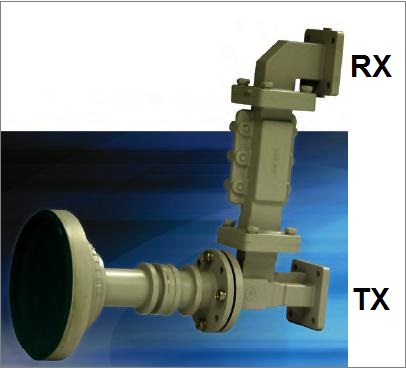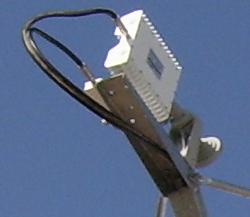Post by Eric Johnston on Oct 4th, 2007 at 9:37am
If you can use a ladder so as to reach up under the feed arm to make the polarisation adjustment that should be fine, as you won't be blocking the beam. The person adjusting needs to be using a phone to talk to the hub while the adjustment is made. The movement required to get into the deep cross polar null is very small as the deep null is only a degree or two wide.
The assembly of the feed horn to the OMT is important. The two flanges are both circular, they must be clean and they must align exactly straight and co-centric. If there is a circular rubber O ring check the flanges are parallel. The 4 screws need to be all done up the same. The diameter of the screws should be such that there is no possibility of a sideways misalignment.
Someone who installed a transmit reject filter the wrong way round had a poor cross pol performance.
Note the longer end of the TRF is towards the feed (in this specific correct example). Note the faces of the two circular waveguide flanges at the circular joint are parallel. The four screws are tightened evenly.
Your present feed configuration is shown below:
The polarisation appears to be set for vertical receive with almost zero adjustment angle applied. Maybe your satellite is almost due south ?
Check your required polarisation adjustment angle with:
https://www.satsig.net/maps/satellite-dish-pointing-iraq.htm
If the answer is that a positive polarisation adjustment is required, then from the nominal horizontal or vertical starting position, rotate the feed clockwise, while facing towards the satellite.
Best regards, Eric.
The assembly of the feed horn to the OMT is important. The two flanges are both circular, they must be clean and they must align exactly straight and co-centric. If there is a circular rubber O ring check the flanges are parallel. The 4 screws need to be all done up the same. The diameter of the screws should be such that there is no possibility of a sideways misalignment.
Someone who installed a transmit reject filter the wrong way round had a poor cross pol performance.
Note the longer end of the TRF is towards the feed (in this specific correct example). Note the faces of the two circular waveguide flanges at the circular joint are parallel. The four screws are tightened evenly.
Your present feed configuration is shown below:
The polarisation appears to be set for vertical receive with almost zero adjustment angle applied. Maybe your satellite is almost due south ?
Check your required polarisation adjustment angle with:
https://www.satsig.net/maps/satellite-dish-pointing-iraq.htm
If the answer is that a positive polarisation adjustment is required, then from the nominal horizontal or vertical starting position, rotate the feed clockwise, while facing towards the satellite.
Best regards, Eric.

